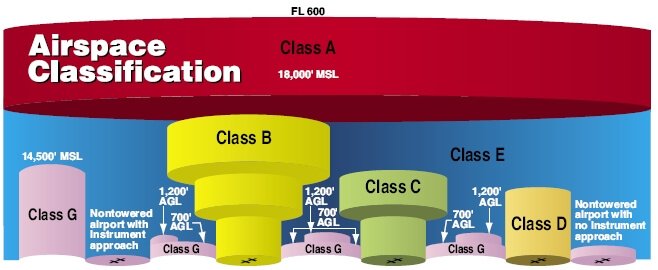As a drone operator you should be diligent in understanding the FAA requirements for flying an sUAS in the United States. A Recreational pilot must notify all airports within 5 miles of their flight.
As a recreational operator, to fly in your backyard, even if you never go higher than the trees, you are required to call. Where I live there are five airports or heliports within five miles.
I took my Part 107 partially to better understand the rules and came away more confused. It has taken me a while and a lot of searching but I believe I can now explain in simple terms.
The Difference a Part 107 Makes
The Part 107 is all about Class G airspace. Class G airspace is the airspace below 14,500 ft MSL that is not designated Class B,C,D or E.
Airspace is about airports, and Class E and G are the areas that an airplane can fly without communicating. A Drone Pilot (DP) cannot fly in Class E without authorization but that leaves Class G space. As far as drones (sUAS) are concerned, Class G is uncontrolled airspace.
Airspace for Drones
Here are some general rule to breakdown airports and the airspace created by them.
- An airport with no tower or instrument approach remains Class G.
- Class D airports with no instrument approach revert to Class G airspace when the tower is not operating.
- An instrument approach can lower the floor of the Class E to the surface. Class E to SFC can extend up to 30 miles from a Class B and up to 20 miles from a Class C airport.
- An airport with an operating Air Traffic Controller (ATC) is Class B, C, or D.
A COA or COW is required to fly in controlled space and all contact requirements will be spelled out in the certification. While it is considered good practice to inform airports before you fly under Part 107 there is no requirement to do so.
The Five Mile Rule
The five mile rule includes all airports and heliports. While this may be a good rule of thumb as I pointed out it misses instrument approaches (Class E to SFC) which may extend 20 or 30 miles from the airport. Being outside of five miles from any airports doesn’t mean you are in Class G space.
It should also be noted that four nautical miles is generally the extent of a Class D cylinder and that is about 1/2 mile smaller than five surface miles. The airports I need to call to fly out of my backyard as a recreational operator are more than four nautical miles away in addition to being Class G space (no instrument approach, no tower).
Bottom line
As a Part 107 Remote Pilot you can fly in Class G space and there is no requirement to notify the airports. Heliports and airports without an instrument approach or operating tower typically do not change the Class G classification.
Class B and C airspace are shaped based on other airports and geography so the five mile rule is a rule of thumb and not the actual boundary. Obtaining a Part 107 and understanding airspace will make you a safer operator and makes it easier to fly your drone in many areas.
Like in my situation. The trees around my house are 160 ft tall. I am comfortable flying in the unusable airspace of my backyard without making any calls because a notification would serve no purpose. I can do that because my house is in Class G airspace.
With a Part 107 you can also apply online for a Certificate of Authorization (COA) or Waiver (COW) which makes it possible to fly in airspace other than G, at night, higher than 400 ft AGL, etc. NOTE: This can be a lengthy process taking up to 90 days to obtain approval (or be denied) for each online submission.
There are clear advantages in obtaining your Part 107 in addition to being able to fly for hire. The first step is to understand where Class G airspace exists.
Summary
 Notice the Class G cylinder depicted on the far left. The cylinder on the far right, ‘Nontowered airport with no instrument approach’, should look the same. This is because the Class G Space should go up to 14,500 MSL. The representation is not in error but the short cylinder is misleading. The point I hope you take away from this post is that Class G space isn’t cylinder shaped, its the filler under Class E!
Notice the Class G cylinder depicted on the far left. The cylinder on the far right, ‘Nontowered airport with no instrument approach’, should look the same. This is because the Class G Space should go up to 14,500 MSL. The representation is not in error but the short cylinder is misleading. The point I hope you take away from this post is that Class G space isn’t cylinder shaped, its the filler under Class E!
The numbers next to a Class E designation doesn’t have a correlation with the floor so a Class E3 or Class E2 isn’t any kind of indicator. Class E to Surface is what restricts a 107 Pilot.
2016 AIM, chapter 3-2-6, subsection e
“TYPES of Class E Airspaces:
1. Surface area designated for an airport.
2. Extension to a surface area.
3. Airspace used for transition.
4. En Route Domestic Areas.
5. Federal Airways.
6. Offshore Airspace Areas.
7. Unless designated at a lower altitude…”
The Class E floor is typically 1200ft (sometimes 700ft) and the Part 107 pilot should be flying at or below 400ft so why is it a concern? In the case of an instrument approach, the Class E to surface area may extend 20 miles from a major airport.
Visit AirMap.com and look at Homer, AK. The Class E to surface approach area has different floors rather than just extending to the surface for 20 miles.